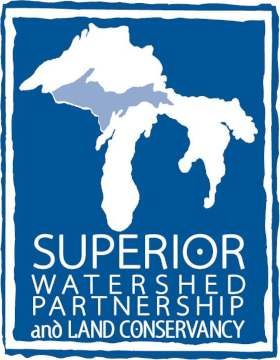Stormwater Education K-12
Projects > Stormwater Management > Stormwater Education K-12
Fixing our problems with stormwater pollution is usually an effort taken on by adults, but it's just as important to teach the next generation how to prevent and reduce their impact on the Great Lakes.
To that end, the Superior Watershed Partnership has worked with students of every age group across Marquette to educate our younger citizens on good stewardship of Lake Superior and its waterways. Third-grade students at Sandy Knoll Elementary, for instance, have been learning about plastics pollution in the Great Lakes through a variety of lessons over the last two years.
They've helped the Great Lakes Conservation Corps clean up beaches, learned ways to protect Lake Superior and its watersheds, and participated in SWP's red bucket program to reduce cigarette waste that ends up in the lake through storm drains. Cigarette butts are the top piece of trash found on beaches, but they usually get there by being tossed on a city street and traveling through the stormwater systems when it rains or when snow melts.
"We’ve involved Sandy Knoll third graders for the past two years in a 'red bucket campaign,' distributing red cigarette butt collection buckets to businesses around town," says Abbie Debiak of the SWP. "The thought being to encourage residents and tourists to properly dispose of cigarette butts so that they don’t get washed into Lake Superior."
SWP has also worked with teachers at Sandy Knoll to discuss plastics as a problem facing Lake Superior, and much of the plastic waste plaguing our waters ends up there from the stormwater system. So, good stormwater education is a key tool in preventing plastic pollution, too.
One great way to connect with and teach students is through visual projects that can help bring home the impact of stormwater pollution. Local artist Stella Larkin created a large mandala of discarded plastic debris that was collected along a short stretch of Lake Superior beach, which she, along with SWP educators, has presented to several classes ranging from elementary to high school. The materials all came from the stormwater drains of Marquette after a large rainstorm that swept through the area in October of 2017.
"She walked a short stretch of beach (approximately 200 feet) and collected all sorts of different plastic that had washed up on the beach – incorporated it into the piece – and now it’s used as an educational tool to bring awareness to plastic pollution in Lake Superior," says SWP project planner Abbie Debiak. "Stella and I also presented the piece to multiple high school classes at Marquette Senior High School in November of last year."
Superior Watershed Partnership also works to get children and students involved in year-round pollution prevention and reduction efforts, like beach clean-ups, visits with the Great Lakes Conservation Corps to talk about the Great Lakes, and education on storm drains and stormwater waste.
Last year, Marquette Alternative High School students helped the SWP plant 286 red and white pines, which are native to the area, along Lakeshore Boulevard and on Presque Isle in Marquette.
"Non-native Lombardy poplar trees were removed, and native trees were planted to improve the nearshore waters of Lake Superior," says Debiak. Native trees in particular do a better job of rooting deeply and preventing soil erosion, along with providing a stronger filtering system for stormwater running off into the lake.
Debiak is the coordinator for the Upper Great Lakes Stewardship Initiative as well, which has the goal of helping K-12 students in Michigan learn about the lake ecosystem they live in, and helping them become better environmental stewards.
In 2015 and 2016, the initiative worked with students at Graveraet Elementary to explore lessons on Lake Superior and stormwater management. They visited the beach and saw the City of Marquette's then-brand-new Lakeview Arena stormwater pond, learning about how stormwater throughout the city ends up in Lake Superior with the help of city water treatment staff. The third-grade students learned how to test pH in water, and discussed how and why their test results from the lake and pond were different.
The funding for these projects comes from a variety of sources, including the Great Lakes Fishery Trust, the Great Lakes Stewardship Initiative, the U.S. Forest Service, the Great Lakes Restoration Initiative and United Way of Marquette County.
The SWP is committed to helping educators, parents and children learn more about the Great Lakes and pollution prevention in any way possible. We've also collected a solid list of resources for teachers and students to use to learn more about their environment through subjects including math, technology, engineering, science, social studies, art and music. For teachers looking for professional development credits in the field of environmental education, we've got another list for that too.
Many agencies from the state to the national and international levels offer useful resources, like the Michigan Environmental Education Curriculum Support Materials from the DEQ, or the Center for Great Lakes Literacy, which is connected to Sea Grant programs. If you know a classroom or teacher interested in environmental education, there are even more resources, for instance this from the EPA on stormwater pollution, and more Great Lakes-specific education from the NOAA here.
The Superior Watershed Partnership staff is also available to help local schools, classrooms and students get involved in protecting our Great Lakes and watersheds.
Projects > Stormwater Management > Stormwater Education K-12
